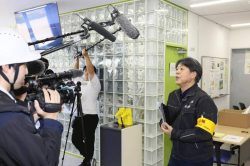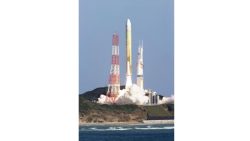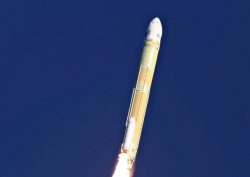
The Vera C. Rubin Observatory is seen during the sunset, in Coquimbo region, Chile, on May 17.
12:14 JST, June 28, 2024
SANTIAGO (Reuters) — With a resolution above 3.2 gigapixels, a nearly three-ton weight and the ambitious task of carrying out an unprecedented decade-long exploration, the largest digital camera ever built for optical astronomy is ready to be installed under the clear skies of northern Chile.
The pieces required to assemble the Vera C. Rubin Observatory — which includes a ground-based telescope and the camera — traveled in several vehicles to the summit of Cerro Pachon in the Coquimbo region, on the edge of the Atacama desert, some 565 kilometers north of Santiago.
“Everything that we needed for operations [is] now on the summit and ready for checkout and hopefully for installation a little bit later this year,” said Stuartt Corder, chief science officer of the AURA association of universities and deputy director of the NOIRLab center, which will operate the observatory.
According to its website, the Rubin Observatory is a complex, integrated system consisting of an eight-meter wide-field ground-based telescope, the camera and an automated data processing system.
It will generate approximately 20 terabytes of data per night and its ten-year exploration will produce a catalog database of 15 petabytes.
The goal of the exploration will be to understand the nature of dark energy and dark matter in the universe — of which only a small part is known — as well as studying the possibility of Earth colliding with asteroids, or stars and planets close to the sun.
“That’s a really inspiring moment where you can say — we’re starting. We’re standing here at the precipice, getting ready to start a campaign that in ten years, we hope will answer the questions of … when the universe was made and started into motion … and how will it continue to evolve in the future?”
The result might not depart from what we already know, but they will help refining our understanding of the universe, Corder said.
AURA is a consortium of 47 U.S. institutions and three international affiliates that operate astronomical observatories for the National Science Foundation and NASA. It is responsible for managing, among others, the NOIRLab center.
Chile hosts much of the world’s investment in astronomy thanks to the clear skies of its Atacama Desert, the driest desert on earth.
"Science & Nature" POPULAR ARTICLE
-

‘Fiercest, Most Damaging Invasive Weed’ Spreading in Rivers, Lakes in Japan, Alligator Weed Found in Numerous Locations
-

Japan Set to Participate in EU’s R&D Framework, Aims to Boost Cooperation in Tech, Energy
-

Tsunami Can Travel Vast Distances Before Striking, Warn Japanese Researchers
-

Univ. in Japan, Tokyo-Based Startup to Develop Satellite for Disaster Prevention Measures, Bears
-

Japan’s H3 Rocket Failed in Latest Launch, Says Official
JN ACCESS RANKING
-

As Chinese Tourists Shun Japan, Hotels and Stores Suffer
-

Osaka-Kansai Expo’s Economic Impact Estimated at ¥3.6 Trillion, Takes Actual Visitor Numbers into Account
-

Japan Govt Adopts Measures to Curb Mega Solar Power Plant Projects Amid Environmental Concerns
-

BOJ Gov. Ueda: Highly Likely Mechanism for Rising Wages, Prices Will Be Maintained
-

Economic Security Panels Debate Supply Chains, Rare Earths; Participants Emphasize Importance of Cooperation Among Allies






















